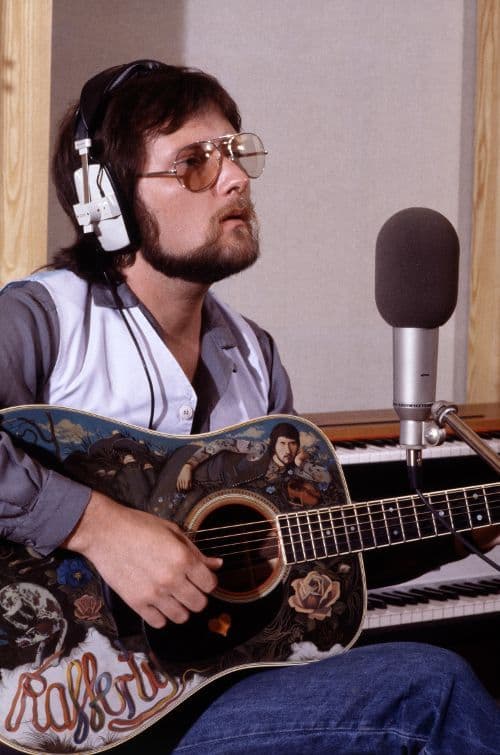
A restless wanderer under the saxophone’s cry — “Baker Street” by Gerry Rafferty
When Gerry Rafferty released “Baker Street” in February 1978, the song immediately found its place in the hearts of listeners around the world. On the UK Singles Chart it peaked at No. 3, marking Rafferty’s highest solo chart position in his homeland. In the United States it climbed to No. 2 on the Billboard Hot 100 and held that spot for six consecutive weeks, while topping the Cash Box chart.
What many remember first is that unforgettable saxophone riff—etched into the fabric of popular music—but beneath that shimmering hook lies a deeply personal story of creative stasis, longing, and escape.
Rafferty had emerged from the ashes of his former band, Stealers Wheel, whose 1973 hit “Stuck in the Middle with You” brought him to the public eye. But by 1975 the band had disbanded and legal entanglements kept Rafferty silent, unable to release new material for several years. During that liminal period he frequently travelled between his home in Paisley, Scotland, and London — and it was during one of those nocturnal treks that the seed for “Baker Street” sprouted.
He spent nights in a friend’s modest flat off London’s famed street of the same name, staying awake, playing guitar, talking, riding the dawn train back north. The loneliness of that commute, the feeling of being “in between” — not quite free, not quite captured — infused the song’s soul. The lyrics speak of a city that “makes you feel so cold… it’s got so many people but it’s got no soul,” capturing a man who dreams of owning a home, but instead drinks the nights away, and realizes that maybe he’s “a rolling stone” with no direction.
Then the saxophone enters. That soaring solo — played by session musician Raphael Ravenscroft — became one of the most iconic instrument breaks in pop history. It quite literally lifts the song out of its introspective grey, giving it an emotional sweep that lingers.
In many ways, “Baker Street” is a bridge between worlds: folk‑roots Scottish songwriting meeting soft‑rock’s mainstream sheen; a man’s past with the possibilities of his future; the homebound heart reaching for something beyond. Rafferty modestly acknowledged that the song had become his “classic”… and indeed it proved to be one of the few that endure across generations.
For the listener of a certain age, there is real resonance. The mid‑1970s were a time of transition: the shine of the ’60s had faded, uncertainty lay heavy, cities felt less warm. To hear those opening lines — “Winding your way down on Baker Street / Light in your head and dead on your feet” — is to feel the fatigue, the yearning, the hope and the regret all at once. And to let the sax break wash over us is to remember what it felt like for a fleeting moment to imagine freedom — moving beyond the constraints of contract, of expectation, of personal demons.
Within the frame of its release, “Baker Street” stood out. Amidst the emerging punk and new wave movements, this was a quiet, introspective anthem of escape. It reminds us that sometimes the softest voice can carry the deepest ache. And it invites us, still, to walk down that street in our minds, suitcase in hand, the train’s whistle in our ear, dawn breaking somewhere ahead.
So when you listen again, perhaps pause at the sax. Let it take you back — to that flat in London, to that early‑morning train, to the yearning for “home” and for “something more”. For the heart of “Baker Street” is not just the street itself, but the journey within.